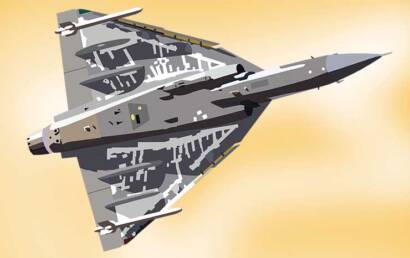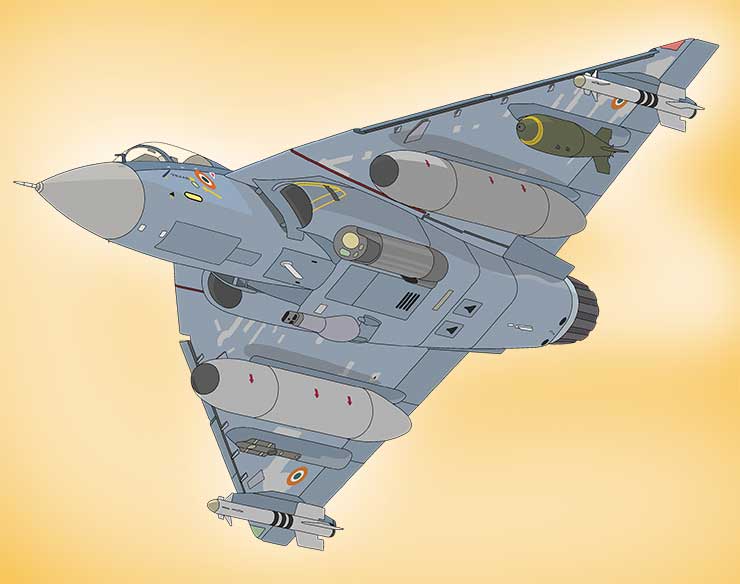
On 13th January, India’s CCS (Cabinet Committee on Security) chaired by the Prime Minister, cleared the procurement of 83 LCA Mk 1A for the Indian Air Force (IAF) from Hindustan Aeronautics Limited (HAL) for Rs 48,000 crores. This follows the earlier order of 40 Mk 1 aircraft by the IAF, thus making a total of 123 aircraft production run for HAL. This order is the culmination of a long-expected demand for series production of the indigenous fighter aircraft and is a huge boost for the Indian defence industry.
With an increasing focus on Atmanirbhar Bharat (self-reliant India), the national leadership needs to ensure that this is just the beginning of a well-crafted strategy. Aerospace capability is vital for India to become self-sufficient in critical technologies. The success of the manufacturing program of the Tejas is a vital national requirement. However, it is prudent to keep in mind a few lessons from the past to ensure mistakes are not repeated.
India’s first indigenously designed fighter, the HF-24, more than half a century ago was an exceptional achievement, given the state of technology and conditions that existed then. It was one of the best designs in the world at that time but became a victim of the Cold War geopolitics as India faced technology denials, particularly for aero engines. Although the aircraft served the IAF well, it was handicapped by underpowered engines and was phased out prematurely in less than two decades of operations. Despite its well-proven design, there was a lack of strategic continuity of persisting with follow-up designs and upgrades. A further handicap was India’s self-defeating policy of banning armament exports.
Contrast this with France’s national strategy, articulated by its leaders immediately after 1945, wherein the defence industry and armament exports formed the most critical component of rebuilding their economy. The logic was clear – defence industry and armament exports had a vital role in nation-building in terms of science and technology, education and skills, research and economic development. The French defence industry, which was dependent on American assistance and license production till the 1950s, achieved its complete self-reliance by the 1960s when they became a major exporter of arms to over 100 countries.
The Tejas has taken more than three decades to series production. With the challenges of long development behind us, the IAF’s order of 123 aircraft forms the foundation for the Indian aerospace defence industry to transform into a major exporter. The Tejas should form the linchpin of our export strategy. It is important to recognise the various factors that are present now that can work for this strategy. Some of these are:
- The HF-24 was developed and manufactured entirely by HAL. Although HAL produced 143 aircraft, there was practically no participation by the private sector due to government policy, and hence an aeronautical ecosystem was absent. In contrast, the Tejas enjoys a completely different environment. While HAL has played a major role in its development, the Aeronautical Development Agency (ADA) under the Ministry of Defence has involved over 500 institutions and private and public industries in the design and development process. This has ensured that today we have a vibrant ecosystem waiting to take off.
- Earlier, there was neither an incentive nor any intention to work towards an export strategy. Thankfully, this policy has been reversed. An aggressive export strategy is vital for India’s technology growth and self-reliance.
- India did not follow the principles of successive-variants approach to ensure continuity of development and upgrade strategy. It is vital that the Tejas program follows this strategy to ensure continued improvements and remain competitive.
- HAL’s role as the overall system integrator and the delegation of majority of the work to its subcontractors is a major transformation that is vital for success. It will allow HAL to focus more on product improvements, product support, and control over its supply chain. This will ensure it meets its timelines.
- Adhering to derivative model strategy is the best way to ensure continuous refinement and upgrades. Besides, it allows the industry to build a huge database of user feedback. Mk 1 and Mk 1A are thus the right way forward. Similarly, Mk 2 and TEDBF are worthwhile developments as they derive their foundational design and proven technologies from the Tejas. Similarly, the AMCA development will benefit immensely from such a strategy.

If strategized properly in terms of cost, timely delivery and product support, the Tejas can become an excellent export prospect even though the global fighter market is ruthlessly competitive and is exceptionally difficult for new entrants. This requires an integrated effort that combines foreign policy, military diplomacy and aggressive defence marketing and cooperation. Since the Mk1/1A incorporate critical equipment that are of foreign origin (for example the GE engine), it makes eminent sense to create risk-sharing partnerships with these companies to ensure successful exports.
Effectively, this 4/4.5 generation aircraft should be pitched as the best value for money to a large number of countries in Asia, Africa, Europe and Latin America. While the Mk 1 and 1A becomes the most affordable and best value for money high-performance aircraft, the trainer by itself has immense potential. The Tejas trainer is an ideal aircraft for the LIFT (Lead-In Fighter Trainer) role for all air forces.
Export of the Tejas Light Combat Aircraft is vital for the Indian aircraft industry and the establishment of a vibrant aerospace manufacturing ecosystem. A successful export strategy could result in a production run of 400-500 additional fighters. This would energise the industry, develop a huge pool of highly skilled manpower, and boost the quality of Indian aircraft manufacturing. In turn, it would accelerate the development of next-generation aircraft such as the AMCA, UAVs/UCAVs, and maybe even the development of a bomber. In sum, export strategy for the LCA-Tejas must start at the earliest, now that the IAF’s order for 83 Mk-1As s a reality.
–The writer is an AVSM VM PhD (veteran), was the former DCIDS (PP & FD) at HQ IDS. He is the President of The Peninsula Foundation (TPF), a policy think tank based in Chennai








